
OVERVIEW
Wall Street is synonymous with the Financial District and the nature of the business conducted in this area for about 225 years.
There are many sights that are worth a visit and the street can tell many interesting stories.
The street is named for the wooden stockade constructed under the then Dutch colonial governor Peter Stuyvesant on the northern boundary of New Amsterdam.
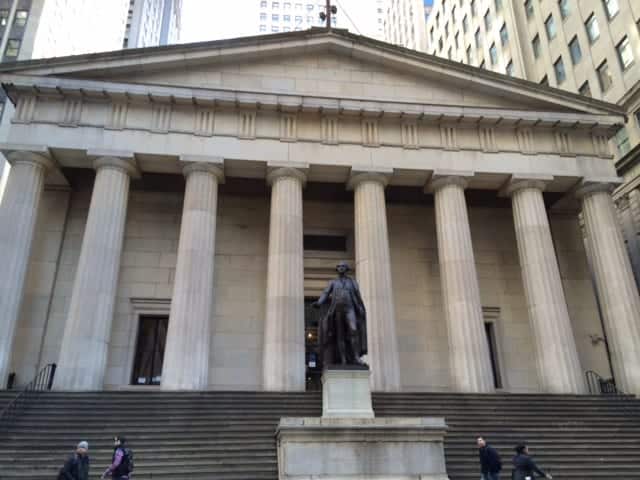
Federal Hall (former US Treasury Building)
Wooden markers in the cobblestone street are reminiscent of the wall designed to protect the Dutch colony from the British invasion.
Our self-guided tour of Wall Street walks you through this history.
We also provide include Wall Street as well as the Financial District on our Lower Manhattan Walking Tour as well as a few other of our pay-what-you-like New York tours:
- Downtown Manhattan Tour
- New York in a Day Tour
Wall Street is also a stop on our GPS-enabled audio tour of Lower Manhattan. Listen to a clip below.
If you are interested in taking a guided Wall Street tours catered specifically to those interested in finance, then you might want to consider a guided Wall Street tour.
How to Get to Wall Street
Wall Street is located in the heart of New York City’s Financial District in Lower Manhattan. The street stretches from Trinity Church in the west to the East River in the east.
There are several subway stations that you could use to access Wall Street.
We recommend using this link for directions to Wall Street as well as our posts:
SELF-GUIDED WALL STREET TOUR
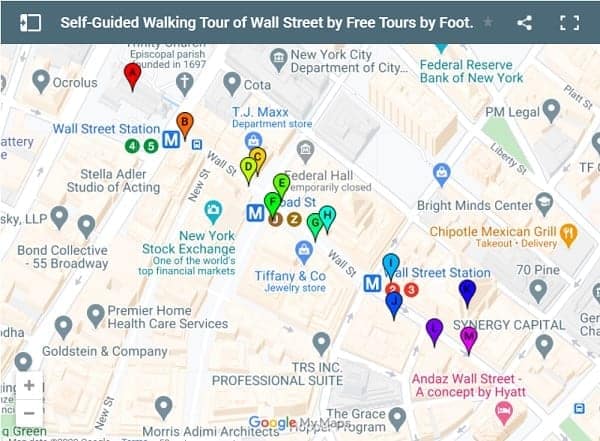
Click the map to enlarge
A – Trinity Church – Corner of Wall Street and Broadway
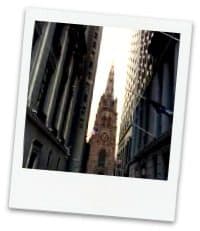
Before you start the tour, admire this beautiful Gothic-inspired church.
Its steeple measures 284 feet (87 meters) and was once the tallest building in all of New York City.
It’s strange to see Trinity dwarfed by all of the larger modern buildings surrounding it (of course, the tallest building in New York is One World Observatory).
Take a quick look inside to admire its stain-glassed windows and roam about its graveyard.
The earliest burial dates back to the early 16oo’s when New York City was called New Amsterdam.
Notable burials include American Founding Father Alexander Hamilton (of $10 bill fame) as well as Robert Fulton, who invented the first viable steamboat.
Read our self-guided tour of Trinity Church and its graveyard.
B – Bank of New York – 1 Wall Street
The first building on the right as one enters Wall Street from Broadway is one of the best-designed buildings of Ralph Walker.
In the Art Deco style, the building was constructed between 1929-32 for the Irving Trust Co.
Through the tall windows, passersby are gifted with a view of the flaming mosaic walls designed by Mildred Meière.
The Bank of New York, founded by Alexander Hamilton in 1789, was the first stock traded on the New York Stock Exchange in 1792.
C – Bankers Trust Company – 14 Wall Street

Located on the left side of the street, and built in 1912 by Trowbridge & Livingston, the stepped pyramid at the top is so iconic that Bankers Trust adopted it as the company logo.
One thing you might notice is that this particular building appears to rise completely vertically, rather than inward steps.
This is because this building was built before New York City instituted its setback laws, which was a response to complaints that buildings like the Bankers Trust Building created a darkened Wall Street below.
You can see the difference between this building and 40 Wall Street, which was built under the new rules.
D – New York Stock Exchange – corner of Wall Street and Broad Street
Originally formed under a buttonwood tree further west down Wall Street, the NYSE moved into this Classical style building in 1903.
Now part of the ICE, the Intercontinental Exchange, the New York Stock Exchange is the largest exchange in the world, responsible for about $169 billion in trading daily.
The sculpture in the Broad Street portico is “Integrity Protecting the Works of Man” by John Quincy Adams Ward.
Be sure to read our full post on the New York Stock Exchange, which includes a virtual tour and video of the trading floors.
E – Federal Hall National Memorial corner of Wall Street and Broad Street
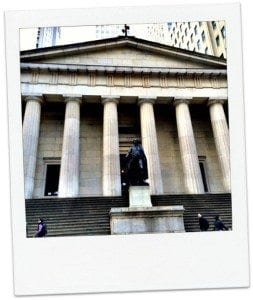
George Washington (also designed by JQA Ward) is standing on what would have been the second-floor balcony of City Hall, which was located on this site until 1812.
Here is where the U.S. Congress met just after the American Revolution and it’s where George Washington took his oath of office on April 30, 1789.
Designed in the Classic style, with Greek and Roman details, the building is said to reflect the democratic ideals of ancient Greece and the power of the Roman Empire.
Step inside to see the former vault in the basement or visit the changing exhibits that are on display in several of the building’s rooms.
The National Park Service also operates a visitor center here. This is a great place to use the bathroom facilities.
F – Morgan Guaranty Trust – corner of Wall Street and Broad Street
The former Morgan Guaranty Trust Company at 23 Wall Street was the bank of J.P. Morgan, who said he did not need a skyscraper as a monument to his wealth since everyone knew how much he was worth.
On the Wall Street side of the building gouges can still be seen under the last two windows from a bomb blast in 1920.
A cart of TNT was exploded, killing 33 people and sending more than 300 to the hospital with injuries.
No one was arrested, although anarchists were suspected of this domestic terrorism, the largest of its kind until the Oklahoma City Bombing.
G – Trust Company of America – 37 Wall St.
Beaux-Arts style building designed by Francis Kimball was the center of the Panic of 1907, which encouraged the Federal Reserve system to be developed.
Today, Tiffany has a satellite store on the street level.
H – 40 Wall Street (The Trump Building)
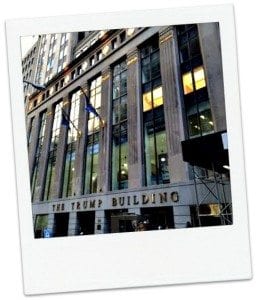
Constructed by H. Craig Severance and Yasuo Matsui for the Bank of Manhattan in 1929, it was designed to be the tallest building in the world.
But architect William Van Alen, who was building the Chrysler Building on 42nd Street, surpassed the height of 40 Wall Street by raising a spire atop the Chrysler Building three days after 40 Wall Street opened.
40 Wall Street is one of our Top 10 Skyscrapers in New York City. Today, it’s owned by a quite famous New Yorker – Donald Trump.
I – Museum of American Finance – 48 Wall Street
The Museum of American Finance is located in the grand hall of the former Bank of New York Building.
The Museum, a non-profit Smithsonian affiliate, is the only independent museum dedicated to providing educational programs on “finance, the financial markets, money, banking, and Alexander Hamilton,” according to their website.
As of August 2018, the museum is closed for renovations.
J – 55 Wall Street
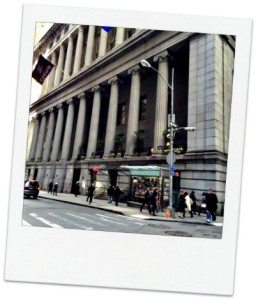
Built after the fire of 1835 destroyed the original Merchants’ Exchange, this three-story Ionic temple-style building boasts 16 single block granite columns of Quincy granite and a commanding central hall that is now an events facility for Cipriani.
The upper floors were added by McKim, Mead & White in 1907 after the custom house relocated from this building to Bowling Green.
Today, the upper floors are 106 exquisite apartments for Cipriani Club Residences.
K – Deutsche Bank – 60 Wall Street
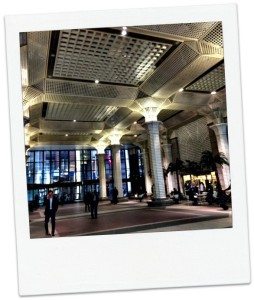
This 50-story skyscraper is the tallest building on Wall Street. Built in 1985 for JP Morgan and Company, it was purchased by Deutsche Bank in 2001.
Once the attacks of 911 damaged the company’s building on Liberty Street, the 5500 employees were relocated here.
The design is a modern interpretation of a Greek temple. On the roof at 737 feet is a solar installation, which is the highest solar PV installation in the world.
This building was rumored to be the real headquarters of the Occupy Wall Street movement, holding events for the group sleeping in Zuccotti Park, just up Broadway.
L – The Crest of 63 Wall Street
The 1929 headquarters of Brown Brothers Harriman; converted to apartments in 2004. The front is decorated with Greek drachmas.
M – Site of the Buttonwood Agreement – 68 Wall Street
An event which instituted the New York Stock Exchange in 1792. Traders gathered outside the building to do their business before moving inside.
The building burned during the fire of 1835, forcing the then non-profit association to move up Wall Street to its present location.
This concludes our tour of Wall Street. If you found this tour useful, please share this friends and family.
Be sure to read about other things to see and do in Lower Manhattan as well as our other self-guided tours of NYC.
Disclosure: We think you should consider our free tours, but we have also provided other options. While our recommendations are always unbiased, we may receive a small share of sales through some of the links below at no cost to you. See the full text.